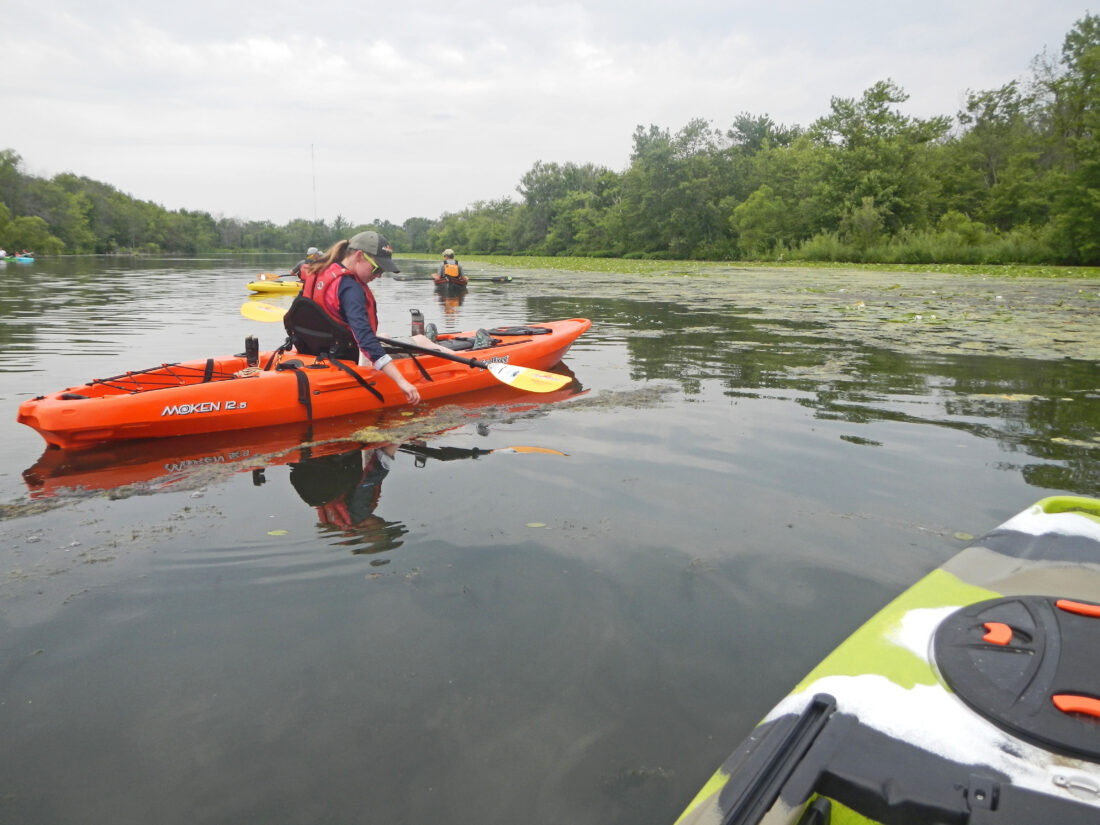What Can You Do For The Lake

Volunteer invasive species paddles provide an opportunity for area residents to get involve with lake and watershed projects. Photo by Elyse Henshaw
There is a common question from the public when it comes time to talk about Chautauqua Lake and the watershed: What can I do to help? Many visitors and residents of Chautauqua County understand and are interested in all of the topics that are at play, like plant growth, harmful algal blooms, funding, and environmental health. However, it is often less clear how they can get involved and help make an impact. With that in mind, let’s take a look at some of the things that citizens can do to take a more active role in improving the health and usability of the lake and its surrounding environment.
PARTICIPATE
A lot of the important dialogue on lake and watershed issues takes place at public meetings. The public is a key part of that. These can include meetings of town or village boards, not-for-profit organizations like the Alliance, science conferences, the Chautauqua County Soil and Water Conservation District, County Legislature, etc. The Alliance will hold its next public meeting on September 8 at 4:30 p.m. at The Lawson Center in Bemus Point. Town or village board meetings are typically held once a month at municipal buildings. Many of these meetings are available via Zoom since the pandemic, making participation easier. These venues benefit from engaged members of the public who bring important issues to the table. It is your involvement that helps inform officials, board members, and staff so that we can do our jobs more effectively.
Many of the lake and watershed projects that are implemented every year are discussed at these meetings. If there is something on your mind, these are the places to go. If you have questions about where money is coming from, and how it is being channeled to help the lake and watershed, these are the places to go. Many of these organizations also hold annual meetings that are great resources if you are interested in learning more about their individual missions. Both the Chautauqua Lake Association and Chautauqua Watershed Conservancy recently hosted their annual meetings, and offered attendees a summary of their activities for the year. On July 18, Chautauqua Institution hosted its Chautauqua Lake Water Quality Conference, a public event with presentations by many of the research teams that are working in and around the lake. If participation is not convenient, consider contacting a member of local government or a staff member of an organization to express your thoughts.
CONTRIBUTE
Funding, both in the short and long-term, is a recurring theme for all of the different stakeholders working in the lake and watershed. There are annual needs for the management of nuisance plant growth, research, monitoring, budgetary needs of individual organizations, and financial requirements for projects that may take years to implement. It can take a lot of maneuvering to get all of these pieces to line up, but contributions from individuals always make a positive impact. The Audubon Community Nature Center, CLA, Chautauqua Lake Partnership, CWC, and Roger Tory Peterson Institute are all not-for-profit Alliance Member organizations that rely on donations in order to do their work.
If there is a particular project, or organization, that you are passionate about, financial contributions always help. And money is not the only way to contribute. Consider donating your time as a volunteer. The Aquatic Invasive Species Early Detection Volunteer Taskforce coordinated by CWC offers opportunities throughout the year for citizens to join in kayak paddles to help identify and remove problem plant species from the lake and Chadakoin River.
TAKE ACTION
There are of course many ways that you can make a difference today by simply working on your own. This could be something as simple as cleaning up trash and debris, or removing plants that have washed up on your shore. If you are a homeowner in the watershed, consider making changes on your property that will help improve water quality in the future. Through its Lakescapes Program, the CWC consults with homeowners and promotes best management practices for landscaping. These include the use of shoreline buffers along waterfronts, native plantings, lawn care, and the proper use of fertilizers.
If you spend a lot of time on the lake, you are a great resource for reporting and monitoring invasive species and harmful algal blooms. Suspicious algae blooms can be submitted through the New York Harmful Algal Bloom System, while sightings of invasive water chestnut, starry stonewort, etc., can be submitted through www.imapinvasives.org. One of the biggest challenges of tracking HABs and invasive species are the “known unknowns”–the problems we know are out there that don’t get reported. Increased participation by the public is a way to fill in those gaps and address issues more effectively.
ENJOY
What is all of this work for if we don’t take the time to enjoy our waterways? The more that we get out on our boats, our kayaks, go fish in our rivers, go walk in our forests, visit lakeside restaurants and shops, the more attached we become to our great natural resources. Increased outdoor activity helps to drive the region forward economically and environmentally. Bringing others along for the ride is an even better idea. The County’s bed tax gathered from visitor stays is used to fund the 2% Waterways Program. The more people that we have coming and staying to enjoy the area, the more money we have to maintain the environment. The Chautauqua County Visitors Bureau does a great job of promoting events through each of the four seasons, and maintains an easy-to-use calendar of things to do at www.tourchautauqua.com. We hope everyone takes the opportunity to enjoy the outdoors during the summer season, but remember that there are plenty of ways to help the lake and watershed (and enjoy them) through the whole year.





